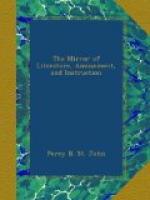“The last which I shall notice of this class of productions, is the portrait of the celebrated demagogue John Wilkes. This singular performance originated in a quarrel with that witty libertine, and his associate Churchill the poet: it immediately followed an article, from the pen of Wilkes, in the North Briton, which insulted Hogarth as a man, and traduced him as an artist. It is so little of a caricature, that Wilkes good humouredly observes somewhere in his correspondence, ’I am growing every day more and more like my portrait by Hogarth.’ The terrible scourge of the satirist fell bitterly upon the personal and moral deformities of the man. Compared with his chastisement the hangman’s whip is but a proverb, and the pillory a post of honour. He might hope oblivion from the infamy of both; but from Hogarth there was no escape. It was little indeed that the artist had to do, to brand and emblazon him with the vices of his nature—but with how much discrimination that little is done! He took up the correct portrait, which Walpole upbraids him with skulking into a court of law to obtain, and in a few touches the man sank, and the demon of hypocrisy and sensuality sat in his stead. It is a fiend, and yet it is Wilkes still. It is said that when he had finished this remarkable portrait, the former friendship of Wilkes overcame him, and he threw it into the fire, from which it was saved by the interposition of his wife.”
All the criticisms on Hogarth’s moral pictures have an air of originality and freshness of mind, which is so attractive, as to make us regret that we have not room for them. In proof of this, only let the reader turn to Mr. Cunningham’s remarks on the Harlot and Rake’s Progress, at pages 98 and 99. His descriptions too of the satirical pictures are extremely ludicrous, and in effect second only to painting itself. The following anecdote of the celebrated March to Finchley is curious, though well known:—
“The original painting was, on the publication of the print, disposed of by a kind of lottery. Seven shillings and sixpence were fixed as the price of a print; and every purchaser of a print was entitled to a chance in the lottery for the picture. Eighteen hundred and forty-three chances were subscribed for; a hundred and sixty-seven tickets, which remained, were presented to the Foundling Hospital. One of the Hospital’s tickets drew the desired prize; and on the same night Hogarth delivered the painting to the governors, not a little pleased that it was to adorn a public place.”
After quoting Walpole’s description of Hogarth’s Sigismunda, in which he says—
“To add to the disgust raised by such vulgar expression, her fingers were blooded by her lover’s heart, that lay before her like that of a sheep for her dinner;—”




